Over five weeks we’ve published a range of Stay Grounded factsheets about various kinds of techno-greenwashing provided by the aviation industry. Here we look at the potential for synthetic electro-fuels, or e-fuels.
Here’s the series:
- Efficiency improvements
- Electric flight
- Hydrogen-powered flight
- Biofuels
- Synthetic electro-fuels (e-fuels)
Alternative jet fuels or so-called “Sustainable Aviation Fuels” (SAF) are liquid hydrocarbon fuels that can be used with existing aircraft in place of kerosene produced from fossil fuels. The industry’s premise of the sustainability of these fuels is to create the fuel using CO2 taken from the atmosphere, rather than using fossil fuels extracted from deep underground that will then emit additional CO2 to the atmosphere when burned. The argument is that blending these fuels with fossil fuels would thereby reduce emissions.
Alternative jet fuel can be broadly categorised into two varieties:
- Biofuels produced from biomass sources (see Fact Sheet 4)
- Synthetic electro-fuels (e-fuels) produced using electricity (explained below)
Synthetic electro-fuels or “e-fuels” can be produced by combining hydrogen with carbon to create a liquid hydrocarbon. In order to minimise emissions, hydrogen must be extracted from water by electrolysis using renewable energy; and carbon must be extracted from the air using a process called ‘Direct Air Capture’ (DAC). These can then be combined, to form a hydrocarbon fuel using Fischer-Tropsch (FT) synthesis. The latter processes must also be powered with renewable energy.
E-fuels are also known as “Synfuels” or Power-to-Liquid (PtL) fuels. E-fuels, as well as biofuels, are drop-in fuels that could be blended with conventional fossil jet fuel (kerosene) and used by the existing fleet. At first sight, e-fuels seem to be the ultimate weapon for decarbonising aviation: they should be able to be used directly in all types of current aircraft, whatever their range; they do not suffer from raw material limitations because they are made from water and air, which are very abundant resources; and the electricity required could itself be generated from the sun and wind, which are very abundant energies. So why are there no aircraft powered by these fuels yet and very few for another ten years or so? Mainly because the production of e-fuels is extremely wasteful of energy. It would deprive other sectors needing to decarbonise as there will not be enough renewable energy available to satisfy all the requirements in the next decades. Also because this is a new industry starting almost from scratch, that still needs to complete process development and set up a whole new sector.
| WHAT THE AVIATION INDUSTRY TELLS YOU | WHAT THEY DON’T TELL YOU |
Happening soon E-fuels could start to be blended with kerosene in 2030. Zero emissions Their production would not cause any CO2 emissions and their combustion would just return to the atmosphere the CO2 from where it would be extracted. Government support required Due to the significant extra cost governments should provide financial support for e-fuels, so that aviation industry growth is not affected. | Too late E-fuels do not address the climate emergency. Although the technology has been demonstrated, it’s still at the pilot stage and several decades of heavy investment would be needed to scale up production. Not zero Even if CO2 emissions can theoretically be reduced down to zero, they would still generate NOx and contrail cirrus that have twice as much climate impact than CO2 today. Requires huge quantities of renewable electricity E-fuels require even more energy to produce than hydrogen, which would deprive other sectors needing to decarbonise. Very low energy efficiency No more than about 10% of the electricity used would be converted into thrust to move an aircraft, whereas it can be used with a much better efficiency in most other applications. Financial support from governments means taxpayers pay Most of whom rarely or never fly… Subsidies for e-fuels risk wasting public money on an expensive solution and would keep flying artificially cheap, resulting in more air traffic and emissions than if the industry paid. |
E-fuels cannot be scaled up rapidly enough to meet climate targets
The deployment of e-fuels is likely to be slow and last several decades. Very few countries have concrete plans for implementation. Currently, only the EU is considering a mandate for e-fuels which starts at only 0.7% in 2030 (link – Annex 1, p. 28) and the NGO Transport & Environment believes that an objective of more than 1% in the EU would be challenging. This is far behind the emissions reduction pace that must be achieved in order to not exceed the globally agreed 1.5°C heating target: according to the United Nations Environment Program (UNEP), worldwide greenhouse gas (GHG) emissions must be reduced by 55% by 2030 (link – p.15).
E-fuels would only partially reduce non-CO2 emissions
Additionally, aviation should not only reduce CO2 emissions but also non-CO2 emissions that have twice as large a climate impact today. Whereas CO2 emissions of e-fuels could theoretically be reduced to zero if CO2 is extracted from the air and renewable electricity is used to produce hydrogen and in all the other processes, this is far from being the case for non-CO2 impacts. Recent estimates indicate that e-fuels will not contribute to reducing non-CO2 impacts by more than 12% versus kerosene.
Producing e-fuels would require huge quantities of renewable electricity that would deprive all other sectors that need to decarbonise
E-fuels could be part of a new economy of hydrogen aiming at replacing fossil fuels where electricity is not a possible alternative. But their production would require huge quantities of renewable electricity: not only must hydrogen be produced from electricity with significant energy loss, but making synthetic fuels from hydrogen requires further process steps with even higher energy losses. Hydrogen needs to be combined with CO2 and the resulting fuel must be processed and purified to make it usable by aircraft engines. CO2 must be extracted from the atmosphere using “Direct Air Capture” (DAC) at high energy cost due to its dilution. No more than about 10% of the electricity spent would be converted into thrust to move an aircraft.
Using renewable electricity to make e-fuel therefore looks like a crazy idea because energy requirements would be huge, whereas renewable electricity is crucially needed to decarbonise the global economy and can be used with a far higher efficiency in most other applications. For example, electricity powering a battery-electric coach results in an approximate 77% power-to-motion efficiency, which is 8x better than if used for an e-fuel powered flight in an aircraft! For the decades to come, the production capacity of renewable electricity will still not be enough to:
- Replace fossil fuel in power plants that supply the electricity grid
- Help satisfy new demand for electricity (cars, heating/cooling, data, etc.)
- Replace today’s grey hydrogen (produced from fossil fuels) used for industrial processes e.g. fertiliser production
- Satisfy new demand for hydrogen for trucks, ships, aviation…

In a scenario where 100% of the airliner fleet would use e-fuels in 2050, the resulting electricity demand would be 20% higher than the current total worldwide electricity production and 4.7 times the production of renewable electricity in 2018 (link, p. 44)! As demand for electricity grows so does the risk that renewable electricity supply won’t be able to match that demand, which will increase the risk of using non-renewable power.
Governments should not subsidise aviation e-fuels: the polluter should pay
The complex process and the huge energy requirements will result in high costs: e-fuels cost six to nine times the price of kerosene in 2020 and would still cost 2 to 3 times more in 2050 (link, p. 48). Governments will therefore be asked for subsidies. These would keep flying artificially cheap which would result in more air traffic and emissions than if the industry were to pay the costs themselves. Taxpayers, most of whom never or rarely fly, should not be paying for that.
Other lesser known issues
The industry is facing a dilemma over the production of the CO2 required: achieving the highest climate impact reduction (60%), would mean extracting diluted CO2 from the atmosphere at very high energy expense, when concentrated CO2 is still available in large quantities from industrial exhaust/chimneys (cement, steel, refineries…). However, if CO2 was to be extracted from factory exhausts, this would just be using fossil fuel a second time and still result in additional emissions ending up in the atmosphere. The climate impact reduction would then drop down to 30% (link, p. 21).
Another rarely mentioned issue is that the manufacturing process produces a mix of hydrocarbons, of which only 50-70% is suitable for aviation. This means that about 30-50% of the renewable electricity used in the process would be wasted for by-products that could be obtained in more efficient ways or for which there are better alternatives.
E-fuels will long be a precious commodity, rare and expensive, that should not be widely used in the future to replace kerosene in quantities much larger than today if the industry keeps growing.

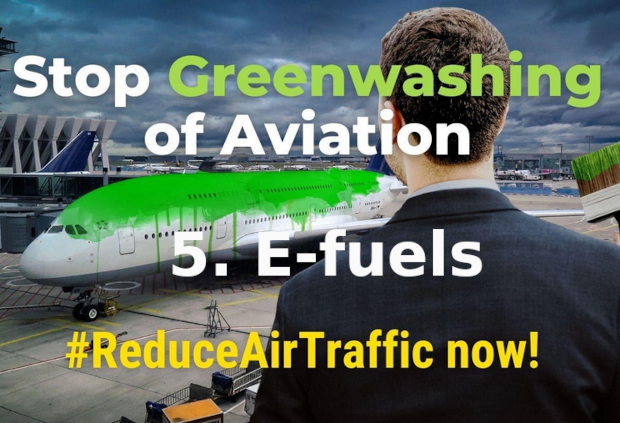
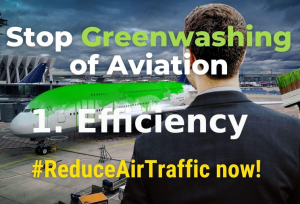
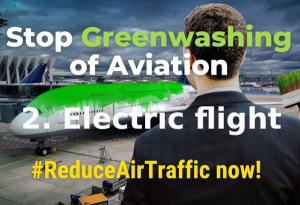
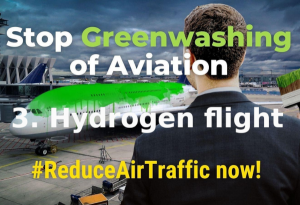
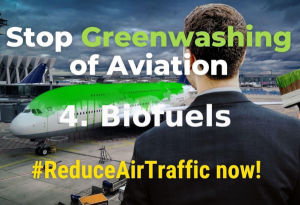
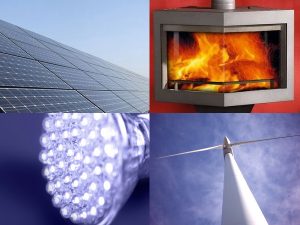

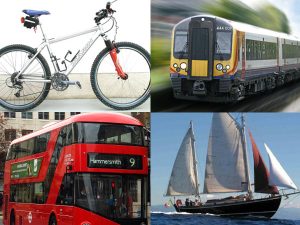

1 Comment
Thankyou for this informative article. I hadn’t heard of “E-fuels”; so I feel ready to talk about the issues when the time comes.